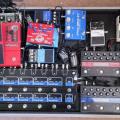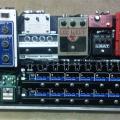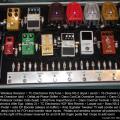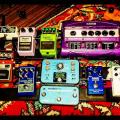Today’s Pedal Line Friday submission is from Jason Williams. If you have a pedal line (doesn’t have to be in a board) for your rig, please email me a photo, bio, description of pedals and routing to pedalline@nulleffectsbay.com. Every Friday I’ll showcase a pedal line submission. Make sure you include any links to your band or music page.
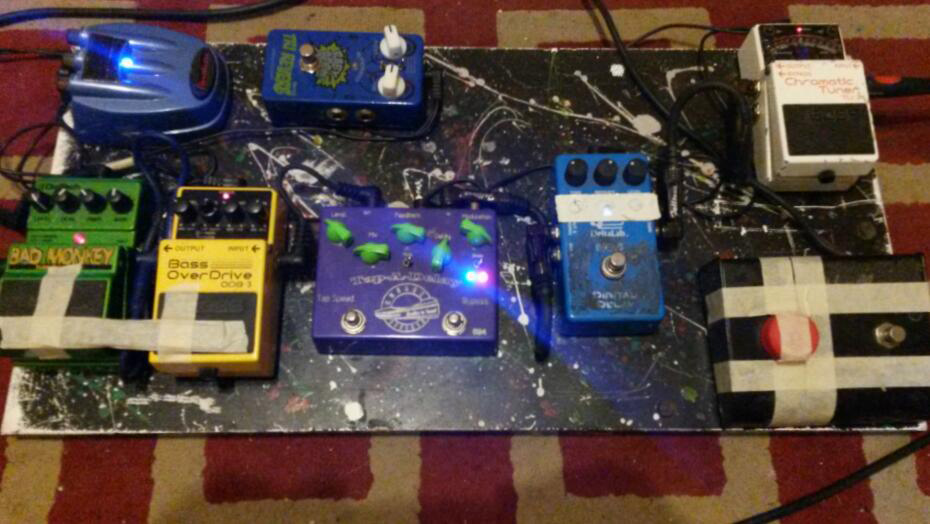
Performing on a record and performing the songs on that record live are two drastically different things for me. In my band, Animal Holograms, when we perform, I’m singing and playing complex chord shapes with my left hand while plucking weird finger picking patterns with my right. That alone takes enough concentration if I’m going to sing in key, remember all the words, and play everything perfectly without looking at what I’m doing. Adding footwork into the mix is definitely a challenge for me, but a necessary and welcome one.
Pedals, as I see it, are tools which allow me to control the dynamics, texture, mood and atmosphere of songs, not just my guitar’s sound. Just like the contrast created by the transition from one chord to another, or a verse exploding into a chorus, the shifting of my guitar’s tones, the sense of an expansion of space or the mutation of the guitar’s sonic texture all create tension and interesting juxtapositions, which plays a huge role in creating a song’s overall character.
On our records, I tend to record guitar tones and capture them as accurately as possible without any external processing. Being an audio engineer, I like to reserve the freedom to be creative with effects as I mix since modern technology allows me to automate every single parameter of an effect with a ridiculous amount of detail and control.
To recreate it live would require at least fifty pedals, and a small army of people with more than two hands each all manipulating parameters and rerouting pedal sequences in a highly precise, choreographed and well rehearsed enormous pedal board routine. An entertaining thought, but an impossible and frankly, undesirable feat.
So, I do what I can with two feet and six pedals, compromising on the level and presence of the richness of ambience achieved by insanely complicated effects automation in exchange for a more focused and energetic performance.
The pedals I’m using right now are a DeltaLab DD1 Digital Delay, a Cusack Effects Tap-A-Delay, a BOSS Bass Overdrive ODB-3, a DigiTech Bad Monkey Tube Overdrive, a Baby Boom series RV-10 Tri-Reverb, a Danelectro FAB Chorus (for vocals) and a BOSS TU-2 Chromatic Tuner. And though not a pedal, I also use a channel switch to control and select between my amp’s three channels–clean, distortion and overdrive. In combination with the two overdrive pedals I use, the channel switch gives me five different guitar tones increasing in level going from clean to gritty and warm to distorted to overdriven and compressed and finally to gigantic bassy and thick, fuzzed out overdrive.
I play a Telecaster Custom and a Jazzmaster through a 1999 Marshall VS-100 (which I bought brand new seventeen years ago), which blares out of a 4×12″ Marshall 1960A cab. My Tele runs into my tuner first and from there it goes into the DeltaLab DD1 Digital Delay and after that, into the Cusack Tap-A-Delay. I choose to have my delays before the distortion and overdrive pedals for a reason. I prefer the sound of a clean guitar signal delayed and then distorted, rather than a distorted signal being delayed. Why?
Distortion naturally adds sustain and a sort of resonance, so when running a distorted signal through a delay pedal, the result is a cluttered up guitar sound obfuscating the attack of chord transitions and making it all rhythmically dull and washed out. Since the distortion is already blunting the attack of each strum by driving the amp beyond a particular limit using gain parameters, the delay is processing a signal with no discernible beginning. Without that, the delay pedalls output gets muddied up as each repetition blurs messily into the next.
In the music I write for Animal Holograms, unexpected chord and key changes are largely responsible for the songs sounding the way they do. Losing the impact of those changes means losing the idiosyncratic or “je ne sais quoi”, the indescribable facets of the songs, which makes an Animal Holograms song distinct from other band’s songs, and makes identifying us with or connecting our sound to genre labels a difficult thing to do. Our songs, like our records, are in constant stylistic and emotional flux. Though the constant creation of new sub-genres like “grungegaze” or “psych-pop” tries to keep up with the evolution of music which inspired the invention of a genre (“shoegaze” for example), unfortunately it’s a noble but futile endeavour since bands are pushing boundaries now more than ever and language is, as it’s always been, poor at communicating the visceral and surrealistic nature of the unconscious mind where music, I imagine, both comes from and interfaces with organically.
For instance, the term “post-rock” is as useless and meaningless to music as “post modernism” is to philosophy and literature. They communicate nothing and conspire to freeze some quality of a few bandsl sound popularized within a brief period of time, seeking to imprison something fleeting in a sentimental enclosure by linguistic force. Used to describe a bandls sound ubiquitously none the less by most people, the terms do more damage than they do good in the effort to articulate musical qualities into words. If it could be done, music as an expressive art form would, to a significant degree, lose cultural relevance. But language doesn’t satisfy the human appetite for numinous experiences or emotional catharsis like music does with it’s ability to move people physically, psychologically, spiritually, philosophically, politically and sensually all at the same time.
A metaphor could be used here to correlate everything I’ve just said about genres with the appeal to a guitar player’s unique and particularly recognizable playing style and overall sound. It’s not the guitar. It’s not the amp. It’s not the effects or the way in which they’re used. It’s not even the culmination of the player’s collective experience with the instrument or writing songs on it. It’s an inchoate pastiche in constant motion of all of these things, which react to and become influenced by a thousand other variables which even the musician him or herself remains largely unaware of.
So, when a guitarist’s playing style is described as being, say: “An abrasive, punk rock influenced playing style, augmented by it’s central role in the context of the ‘synthpop meets folk music’ songs he or she creates to adapt an aggressive playing style to the catchy, approachable mood of his or her songwriting style, reminiscent of the 90ls era indie rock music which emanated from garages and basements in the Pacific northwest”, the only thing being said is that they play a guitar in such a way that you have to combine ineffective, static labels with vague impressions of musical trends long extinct if ever they even existed, resulting in the glimmer of a hope to have made people who haven’t heard anything by this musician understand something about their music, which even the music itself struggles to do at times. Most musicians are struggling to be understood as it is. Static terminology attempting to explain something which is always in a state of transition just seems irrational.
To paraphrase something David Byrne said, “Music is like architecture in motion, and architecture is like music frozen in time”. I love and also absolutely agree with that poetic metaphor. It elegantly makes the case for the existence of similarities between two disparate art forms, despite the inescapable fact that neither satisfy our aesthetic needs which the other provides. A beautiful architectural design as a physical structure provides an experience only as we move around inside of it. A beautiful tonal composition as a musical and abstract structure provides an experience only as it moves around inside of us.
Elucidating the differences between the two, this quote from a lecture given by Professor of composition, Jonathan Cole at the Royal College of Music makes the disparity clear:
“For architecture to come into existence, boundaries of physical space need to be defined. For music to come into existence, boundaries within our experience of time need to be defined.”
But anyhow, I digress. I have been using pedals and other means of achieving certain effects on the demos I’ve been working on for our new album, ‘This is Not a Psych-Rock Recordl, and I’m enjoying the results of a new process and approach to both songwriting and recording.
To listen to a new song recorded using my pedal board, check out “Eschaton on the Television”:
On Sound Cloud:
https://soundcloud.com/animalholograms/eschatononthetelevision_demo
Or on Bandcamp:
https://animalholograms.bandcamp.com/track/eschaton-on-the-television
Thanks for enduring the rant storm. I hope someone maybe got a little something out of it. The new album will be out this July on Monoblack Records.
– Jason Williams
Like us on Facebook:
www.facebook.com/animalholograms
Follow us on Twitter:
www.twitter.com/animalholograms

